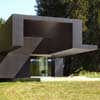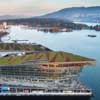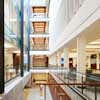Nk’Mip Desert Cultural Centre, South Okanagan Valley, Osoyoos, British Columbia Building
Nk’Mip Desert Cultural Centre, British Columbia : Osoyoos Building
South Okanagan Valley Building design by Hotson Baker Boniface Haden Architects, Canada
31 May 2011
Nk’Mip Desert Cultural Centre Osoyoos
Design: Hotson Baker Boniface Haden Architects
Location: Osoyoos, British Columbia, Canada
Hotson Baker Boniface Haden Architects is now DIALOG : COHOS EVAMY + HOTSON BAKKER BONIFACE HADEN + MOLE WHITE ASSOCIATES + OFFICE FOR URBANISM
Project Overview
The Nk’Mip Desert Cultural Centre is designed to be a specific and sustainable response to the building’s unique context—the unusual Canadian desert found in the South Okanagan Valley in Osoyoos, British Columbia. Sited adjacent to a remnant of the Great Basin Desert (approximately 1,600 acres are being preserved by the band as a conservation area), this interpretative centre is part of a larger 200-acre master plan.
Nk’Mip is the first of a number of new B.C. aboriginal centres, and part of a growing trend to explore the expressive potential of architecture to convey the rich past and the transforming future of aboriginal culture. The practical reasons behind this architectural exploration grow out of provincial leadership—a premier whose efforts to improve aboriginal relations have resulted in changes to the treaty process—as well as a shift in the regulatory environment governing the types of buildings permitted on reserve land.
The building features indoor and outdoor exhibits that celebrate the culture and the history of the band, and is designed to be an extension of the remarkable site, and reflects the band’s role as stewards of the land. The desert landscape flows over the building’s green roof, held back by a rammed earth wall.
The partially submerged building is sited very specifically to focus the visitor’s eye away from the encroaching development of Osoyoos to the west, with the height of the wall set to create a layered view of the desert rising up in the middle ground, receding to the riparian landscape adjacent, and the mountains in the distance. The attenuated entry sequence from the parking area moves visitors through a series of nested concrete walls up to an entry plaza at the end of the rammed earth wall.
The plaza—used for collecting large groups, and signage about events of the day—leads along a low concrete wall that separates the original desert landscape and the building. This route is further defined by channel of water that draws people towards the entry, past the cor-ten steel gate of the service court and administration access. Entry into the interpretive centre occurs at the midpoint of the gently arcing wall.
Inside, a theatre and “black box” exhibition space present information about the band and its historical relationship with the land. The round volume of the “pit house” at the centre of the exhibition space invokes the experience of conversation around a fire.
From here, visitors move through a glazed wall into exterior exhibit space featuring information on native planting, an outdoor performance area and amphitheatre, a tule mat teepee, a large figural sculpture, and a snake research area demonstration space. This area also serves as a trailhead for guided and unguided walks along 50 kilometres of paths through the desert. Small interpretive pavilions and a village of reconstructed pit houses and interpretive sculptures punctuate these trails.
Sustainability Features
The Nk’Mip Desert Cultural Centre is located in one of the most spectacular and endangered landscapes in Canada. Its rare desert condition is the northernmost tip of the Great American Desert, which extends southward as far as the Sonoran Desert in Mexico.
This parcel of land is the largest intact remnant of this unique habitat in Canada. It is part of the land of the Osoyoos Indian Band. This band also belongs to the larger Okanagan Nation which extends down into the US (the Okanagan represents a broader geographic area of bands sharing common language with separate constituent bands). The project’s concern with deep sustainability grows out of the fragility of this landscape, and reflects the core values and history of the band.
The extreme climate made sustainable design a very particular challenge. Hot, dry summers and cool, dry winters see average temperatures ranging from –18 degrees to +33 degrees and often reaching +40 on summer days. The building’s siting and orientation are the first strategic moves toward sustainability: the partially buried structure mitigates the extremes in temperature, and its orientation optimizes passive solar performance, with glazing minimized on the south and west sides. The project’s ambitious approach towards sustainable design also includes the following features:
The largest rammed earth wall in North America
At 80m long, 5.5m high, and 600mm thick, this insulated wall (R33) stabilizes temperature variations. Constructed from local soils mixed with concrete and colour additives, it retains warmth in the winter, its substantial thermal mass cooling the building in the summer—much like the effect the surrounding earth has on a basement.
The use of bluestain pine
A recent infestation of pine beetles in British Columbia has led to an excess of bluestain pine, which here is used in interior and exterior applications. Although bluestain pine is a local material not normally specified for finished building use, Nk’Mip is something of a demonstration project, showing how it can be used both inside and outdoors to celebrate its unique visual qualities As its name suggests, the wood has a blue-tinted cast as though a blue wash has been applied, rather than the typical yellow colour more typical of pine. Although its inherent structural qualities are equivalent, the preferences of the powerful Japanese international market have historically influenced demand for yellow (white) pine.
A habitable green roof
This habitable landscaped roof reduces the building’s visual imprint on the landscape, and allows a greater percentage of the desert landscape habitat to be re-established on the site (replanting uses indigenous species). The roof also provides further temperature stabilization and insulation.
Mechanical features
In-slab radiant cooling and heating in both ceiling and floor slabs create an even, comfortable environment that avoids blasts of air, noise and dust. Coupled with 100% outdoor air displacement ventilation, the system will result in savings of 30 to 50% over a forced air system.
Endangered species research
The building program includes facilities for the band’s award-winning rattlesnake research project, as well as public viewing areas where visitors can see endangered rattlesnakes captured, tagged and microchipped for further study and protection.
Careful water use management
Water is precious in the desert, and a spare channel of water at the entrance along the rammed earth wall introduces this theme. Less visibly, demand on the site fed well is reduced by 40% by incorporating low-flow faucets, waterless urinals, and dual flush toilets.
Rammed Earth Wall
North America’s largest rammed earth wall gives the building exterior a unique material and poetic sensibility, its graduated layers of earth shades evoking geological sedimentation within a distinctly contemporary architectural language. The wall has the appearance of being at once handmade and precise—its layers irregular, and its overall form sharp and geometrical, (the wall’s surface telegraphs the familiar horizontal lines from the wooden formwork used in constructing it) as well as the irregular horizontal strata of the compacted layers of earth used to construct the wall.
Rammed earth construction is a traditional building technique found most often in dry regions where wood is scarce. The modern version of this earth-based wall system combines two –250mm wythes of compacted sand and cement with 100mm of insulation sandwiched between. Successive layers of differently coloured local soils were placed into the 600mm wide formwork and a pneumatically powered tamper was used to compress each layer to about 50 percent of its untamped height.
Sedimentary-like in appearance, the exposed surface acts as the finished wall, is extremely stable and doesn’t off-gas toxic or greenhouse gas emissions. The technique results in a physically strong, durable wall with excellent thermal qualities—heating up slowly during the day in the hot Okanagan sun, and releasing its heat in the evening.
Sustainability of building process also extends to the involvement of band members on the wall’s construction, contributing to the long-term ecological sustainability of the area, of the band, and providing an opportunity to evolve an authentically South Okanagan building technique (something of an antidote to the faux Santa Fe style that increasingly dominates the region).
This project created the opportunity for the Osoyoos Indian Band to develop unique, highly artisanal construction skills as rammed earth contractors and a team of band members worked with the contractor on the fabrication of the wall.
Nk’Mip Desert Cultural Centre – Building Information
DIALOG was retained by the Osoyoos Indian Band to master plan the Nk’Mip Desert and Heritage Centre’s 200-acre site, part of a new resort destination that includes a winery with vineyards, an 18-hole golf course with club house, and tourist accommodation.
Client: Osoyoos Indian Band
Location: Osoyoos, British Columbia, Canada
Context: The eastern shore of Lake Osoyoos, on the Northern tip of the Great Basin Desert, in a 1600-acre conservation area.
Size: 1115 sqm
Completion: Jun 2006
Program
Indoor and outdoor exhibition spaces, theatre, gift shop, administration offices, rattlesnake research facilities, 50 kilometres of trails.
Green Design Features
– Rammed earth wall
– Orientation/Siting
– In-slab Radiant Heating and Cooling (in ceiling and floor slabs)
– Habitable Green Roof
– Use of Bluestain “Beetle” Pine Wood
– Water Use Management
– Support for Endangered Species Research
Materials
Rammed Earth, Concrete, Bluestain Pine Cladding
Structure
Concrete
Mechanical Systems
Passive thermal massing with the rammed earth wall and landscape roof, and in-slab radiant heating and cooling with 100% outdoor air displacement ventilation.
Project Credits
Architecture Team
DIALOG (formerly Hotson Bakker Boniface Haden Architects)
Principal-in-Charge: Bruce Haden
Project Architect: Brady Dunlop
Project Team: Norm Hotson, Stephanie Forsythe, Tina Hubert, Julie Bogdanowicz
Structural Engineering: Equilibrium Consulting Inc.
Principal-in-Charge: Eric Karsh
Project Engineer: Ivan Ursic,
Design Engineer: Ben Heath
Project Team: Ann Tomlinson, Raymond Vitkauskas
Landscape Architecture: Phillips Farevaag Smallenberg
Principal-in-Charge: Chris Phillips
Project Team: Ken Larsson, Mike Enns, Blair Guppy
Mechanical Engineering: Cobalt Engineering
Partner-in-Charge: Ken Newbert
Project Manager: Tim Brown
Electrical Engineering: MCL Engineering – Principal-in-Charge: Marc Langdon
Code: LMDG Code Consultants – Frank Mattia
Exhibit Design: Aldrich Pears Associates – Partner-in-Charge: Phil Aldrich ; Project Managers: Marc Belanger, Richard Lien ; Project Team: Sheila Hill, Victor Chorobik, Megan Long, Val Kan
Acoustic: BKL Consulting – Principal-in-Charge: Doug Kennedy
Theatre Design: Douglas Welch Design – Principal-in-Charge: Doug Welch ; Project Team: Paul Hodson
Theatre Electrical: Acumen Consulting Engineers – Project Manager: Garry Musgrave, Philbert Ang
Live Displays: Bufo Incorporated: Harry Parsons
Retail
Retail Excellence: Natalie Tan – Client: Osoyoos Indian Band
Client Team: Margaret Holm, Brenda Baptiste, Charlotte Sanders, Chris Scott, Mel Wooley
General Contractor: Greyback Construction – Project Manager: Craig Donoghue
Site Superintendent: Ray Eichberger, Armin Helbling, Larry Kenyon
Rammed Earth Wall Sub Contractor: Terra Firma Builders Ltd
Project Manager: Meror Krayenhoff
Photographs: Nic Lehoux Photography
DIALOG
DIALOG was launched in September 2010 as the new name for the merger of leading national design firms Cohos Evamy, Hotson Bakker Boniface Haden, Mole White Associates, and Office for Urbanism.
Nk’Mip Desert Cultural Centre images / information from DIALOG
Address: 100 Rancher Ck, Osoyoos, BC V0H 1V6, Canada
Canadian Architecture
Canadian Architecture Design – chronological list
Linear House, Salt Spring Island, British Columbia
Patkau Architects – added

photograph : James Dow
British Columbia House
British Columbia Architecture
Vancouver CC West

picture : VCCEP
Sauder School of Business Vancouver

picture from architect
Harvest Green Project Vancouver

picture from architect
Website: Nk’Mip Desert Cultural Centre Osoyoos, British Columbia
Buildings / photos for the Nk’Mip Desert Cultural Centre page welcome
Website: Osoyoos, British Columbia

